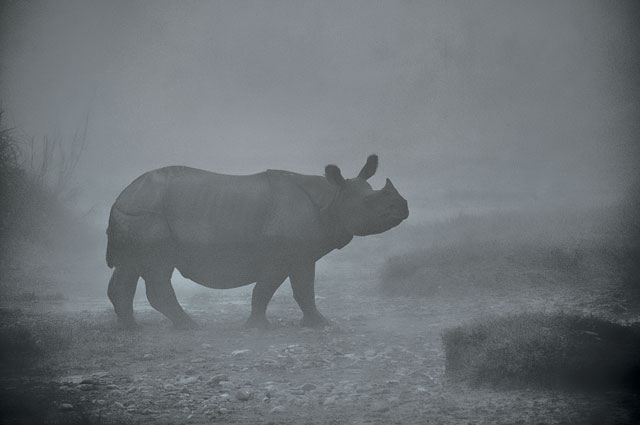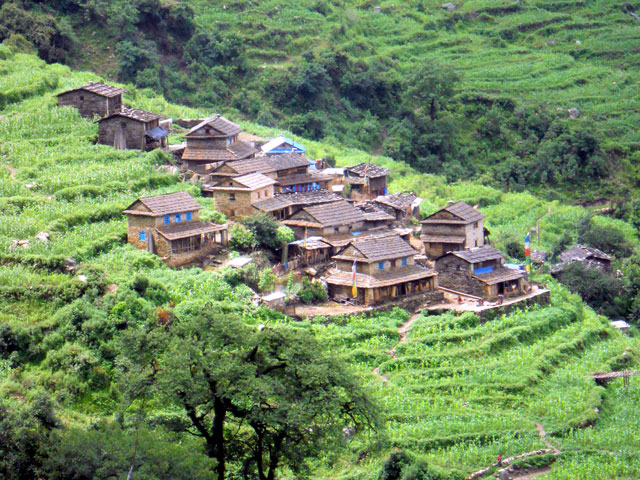Off-season opportunities include everything from all-out exhilarating adventures to revitalizing leisure pursuits that this fascinating Himalayan country dishes up on a continual basis.
 Nepal is world-famous for mountaineering and trekking possibilities, especially in autumn and spring, when the weather is most reliable, and views edge toward sparkly clear. Known as high seasons, autumn and spring are the favored and busiest times of the year to visit the Himalayan highlands, surrounded by towering mountains. These seasons provide a torrent of tourism employment, and a currency infusion for an anemic economy (drained of economic vitality by natural disaster and endless political mischief). Wintertime and the summer monsoon also hold ample opportunities, especially to discover trekking trails in a seasonal parallax—seeing the same terrain with new eyes. Off-season opportunities include everything from all-out exhilarating adventures to revitalizing leisure pursuits that this fascinating Himalayan country dishes up on a continual basis.
Nepal is world-famous for mountaineering and trekking possibilities, especially in autumn and spring, when the weather is most reliable, and views edge toward sparkly clear. Known as high seasons, autumn and spring are the favored and busiest times of the year to visit the Himalayan highlands, surrounded by towering mountains. These seasons provide a torrent of tourism employment, and a currency infusion for an anemic economy (drained of economic vitality by natural disaster and endless political mischief). Wintertime and the summer monsoon also hold ample opportunities, especially to discover trekking trails in a seasonal parallax—seeing the same terrain with new eyes. Off-season opportunities include everything from all-out exhilarating adventures to revitalizing leisure pursuits that this fascinating Himalayan country dishes up on a continual basis.
With a variety of terrain and abundant waterways fed by Himalayan snow-melt, just about any outdoor activity, short of deep sea diving, is possible in Nepal. The altitudinal range is enormous, from near sea level at Jhapa district’s Kenchana Kalan (197 ft, 60 m) to the highest zenith on Earth, Everest’s summit (29,029 ft, 8,848 m), a.k.a. the tip-top of the world. This varied topography of Nepal offers an unusual extreme found nowhere else on the planet. Within a span of 200 km (124 mi), sub-tropical jungle lowlands rise up to the planet’s highest tower of iced-over granite jutting high enough into the skies to pierce the jet-stream.
 Nepal is roughly 15% mountains, 68% hills and valleys, and 17% plains, and these three unique layers melt together along east-west lines. The northernmost layer is the Himalayan region, with over 240 peaks above 6,000 m (19,685 ft). Casual trekking might not always be possible in the uplands in the winter, due to extreme cold and snow and ice blocking routes, but lower level trails in the hills (e.g., Indigenous People’s Trek, Chitwan-Chepang Hills Trek, Guerrilla Trek, and Yarsagumba Trail) are suitable alternatives at that time.
Nepal is roughly 15% mountains, 68% hills and valleys, and 17% plains, and these three unique layers melt together along east-west lines. The northernmost layer is the Himalayan region, with over 240 peaks above 6,000 m (19,685 ft). Casual trekking might not always be possible in the uplands in the winter, due to extreme cold and snow and ice blocking routes, but lower level trails in the hills (e.g., Indigenous People’s Trek, Chitwan-Chepang Hills Trek, Guerrilla Trek, and Yarsagumba Trail) are suitable alternatives at that time.
Likewise, the summer monsoon is not an ideal time in the high hills. Near-constant cloud cover obscures mountain vistas, trails are muddy, and leeches haunt the undergrowth (leeches are typically active during the monsoon above 1,200 m/3,937 ft, and up to 3,500-4,000 m / 11,483-13,123 ft). If you are still looking for a highland trek during the monsoon, then, going north of the Himalaya in the so-called rain shadow is the best option. It might still be a bit cloudy with light showers (remember raingear), but is generally much drier than the rest of rainfall-drenched Nepal. Upper Dolpo and Mustang are two ideal choices for a rain shadow trek; northwestern Nepal generally receives less precipitation than the rest of the nation—Humla, and Jumla’s Rara Lake (Nepal’s largest lake) provide enticing options.
Rivers and waterfalls are roaring in the rainy season, and balmy weather makes it all the more pleasant for wet-and-wild rafting, kayaking, and canyoning. Pokhara is a convenient hub for river activities, and a new zip line from Sarangkot Ridge above Pokhara is a fitting option for people looking for a thrill any time of the year. Nearby the zipline launch is the area’s favorite parasailing takeoff point. When the rainfall abates, tandem gliders with colorful wings float down from the ridge like a swarm of butterflies, while ultra-light aircraft buzz through the skies, temporarily disturbing the landlubbers. An ‘air safari’ offers one of the best vantages imaginable of Pokhara, surrounded by the Himalayan landscape.
At the base of the Sarangkot zipline is a new bungee jumping facility, while one of the most electrifying bungee drops in the world is found at The Last Resort near the border crossing to Tibet. Other activities gaining popularity in Nepal include mountain biking and trail running. Day trips up to longer multi-day tours can be arranged. Nepal now hosts many annual long distance trail races in the highlands, from single day courses to multi-stage events, one of the most popular being a rugged marathon in the Khumbu to commemorate the ascent of Everest by Tenzing Norgay and Edmund Percival Hillary on May 29, 1953 (last year, the marathon date was changed to October, because of the earthquakes in spring). Even bustling Kathmandu Valley has marathon races and an eco-challenge team contest involving running, abseiling, and kayaking, as well as other racing events in the surrounding hills (see www.trainrunningnepal.org).
Sightseeing tours and jungle safaris are open year-round, and make a fine complement to the more energetic and adrenalin-spiced activities. Bardiya and Chitwan are the most popular jungle venues, with first class fun and accommodations, and a chance to encounter exotic wildlife in their natural, undisturbed habitat, including some of Asia’s biggest and rarest mammals—tigers, elephants, and rhinos.To this day, new plant and animal species are being found in Nepal and the Himalaya. In fact, between 1998 and 2008, 353 new species were reported in the eastern Himalaya (comprising Nepal, Bhutan, northeastern India, northern Burma, and southern Tibet). The discoveries include 242 plants, 16 amphibians, 16 reptiles, 14 fish, 2 birds, 2 mammals, and 61 invertebrates. Of the birds, Sykes’ Nightjar (Caprimulgus mahrattensis) was discovered in the Koshi Tappu Wildlife Preserve of southeast Nepal in January 2008.
Beyond the natural wonders, Nepal has boundless historic and cultural treasures. Shrines, temples, and monuments appear at nearly every turn in Nepal, and each has something new to experience. Lumbini is a historic destination designated as a UNESCO world heritage site. It is famous as the birthplace of Siddhartha Gautam, later known by the title of Buddha. Lumbini is located in Nepal’s southern plains, near the border with India. It is here that his mother Mayadevi held on to a sal tree for support while giving birth. The area is marked by Maya Devi Temple, with a small pond nearby, and a pillar built by Emperor Ashoka.
Visitors who want to join a meditation retreat in the land of Buddha’s birth can take the chance at monasteries in Lumbini, as well as in Kathmandu Valley’s Boudhanath area, and a popular Goenka Vipassana center at the northern fringe of the valley. A less busy vipassana retreat center following ancient meditation techniques can be found along the banks of the sacred Bagmati River in southern Kathmandu at the International Buddhist Meditation Center, a donation based center. Most Buddhist courses cover both philosophy and practice, as do some of the city’s Hindu societies, e.g., the Brahma Kumaris have a satellite center in the globetrotter zone of Kathmandu, Thamel. More and more yoga centers have emerged, offering asana (posture) classes, some more traditional than others (Pranaya of Thamel and Patan offers regular Hatha yoga classes, and Himalayan Yogini Home in Pokhara includes esoteric Vajrayana methods).
In Pokhara and Kathmandu, the nightlife sparkles with live-music, and music-festivals are becoming the rage, including the ‘biggest jazz party in the Himalaya’, Jazzmandu, and more. A burgeoning film festival lineup is pleasing, and includes the Kathmandu International Mountain Film Festival. Large bazaars can be interesting places to spend a few hours while browsing and striking bargains (Hong Kong Bazaar, one in Pokhara, and another in Kathmandu, are highly recommended for a taste of local shopping styles), and nowadays, farmer’s markets have emerged to round out a sumptuous palate of delights on offer in the urban sprawl.
Nepal is a festive country with fascinating traditions, lifestyles, and natural treasures from cities to remote rural destinations. It is most famous as a boundless outdoor paradise. Starting with luxuriant greenery of the lowlands to fertile hills surrounded by emerald and golden paddy fields and dense forests on up to arid highlands surrounded by peaks spiraling into the skies. The country is wide open to outdoor activities in all seasons. The hospitable population offers plenty of chances to get involved, or just observe cultural traditions and festivals. From culture to all-out adventure, and everything in between, whatever a visitor might be looking for, Nepal is an all-season destination.











